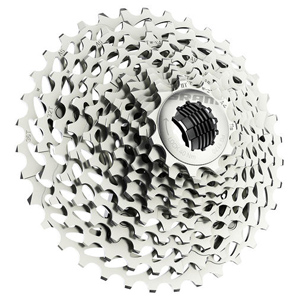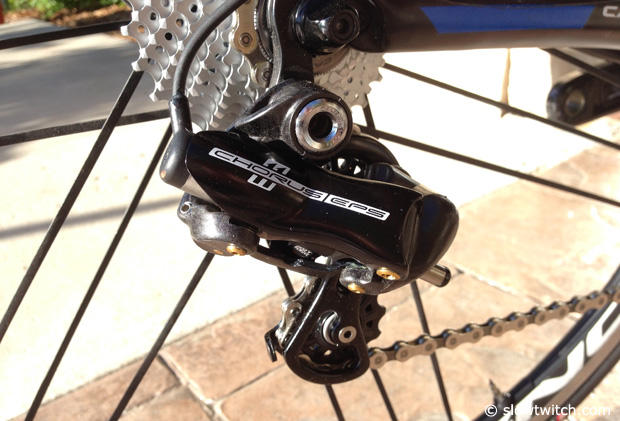Shimano for 2015
I have a genius for averageness. I exist on the arithmetic mean.
You might think being average is no kind of genius, but if not it's at least a convenient talent. You don't need to focus-group anything. You are the focus group. I might wonder, "What do most people want most of the time?" I ask the question, "What do I want most of the time?" And the answer? Cheeseburgers!
See how that works? If I like it, I know you'll probably like it too.
Electronic
But there is one area where I have been reliably at odds with the majority. Those old enough will remember the Miller Lite commercials from the 1980s, with sports bar goers arguing over their beer's best feature. Less filing! No! Tastes great! I am of the opinion that the best feature of Shimano electronic shifting is front derailleur auto-trim. "But no!" say others. "It's shift buttons at the pursuit bar!"
Front derailleur auto-trim! Pursuit shifting! Less filling! Tastes great!
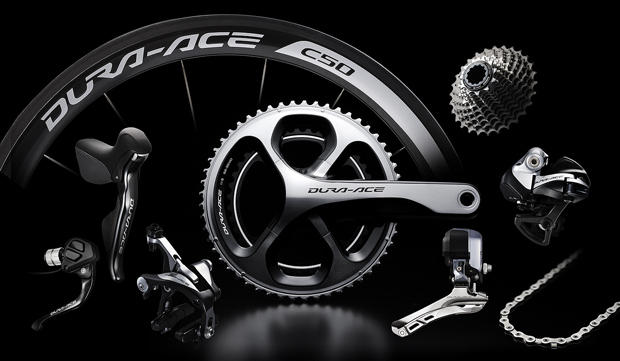
I argued in the beginning, in my first overview of electronic, that shifting on the pursuits doesn't really matter. I ate those words a week later when, during the Amgen Tour of California's "celebrity" time trial in Solvang I rode the one TT course in the history of cycling that required a lot of shifting while out of the saddle, with hands on the pursuits.
Still, I stand by my earlier comment, that the killer app for electronic is front derailleur shifting in general, auto-trim in particular. So that you know what I'm talking about, when you're shifting back on the cassette (the rear gears) sometimes the chain will rub on one side or the other of the front derailleur (FD) cage. You then need to "trim" the FD cage – move the FD slightly closer to or away from the frame – so that it won't make that annoying chain-rubbing noise. Shimano's electronic shifting "knows" where the chain is at any moment, so it "knows" when the chain is getting close to the FD cage and makes an adjustment. Your chain never rubs against that FD cage.
Now, in answer to those who're shouting, "Pursuit bar shifting!" I've found that for every time I've wanted shifting at the pursuit bar and didn't have it, I've had a number of cases where I've had it and didn't want it. If the inside of your thumb, up near the base where your thumb meets your hand, happens to slide by that shift button while your hands are in the pursuits, whoops, all of a sudden you just shifted from the small ring into the big while climbing out of the saddle.
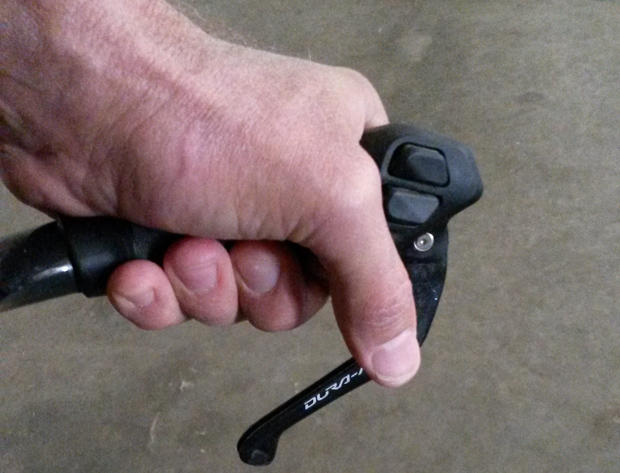
I'm in the minority. Most people think that the benefit to electronic is that extra shifting location down on the pursuits, because most people tend to climb seated with hands on their pursuits. I prefer to climb seated while remaining in the aero position. I find it more comfortable and powerful, as long as I have a low enough gear to spin the climb.
In my opinion Shimano has it wired (so to speak) on front derailleur shifting. FD is where Shimano shines, electronic or mechanical. Nobody can equal Shimano's front shifting performance, and that probably includes Campagnolo although I think it's very close. It includes SRAM mechanical although I do admire the effort and the performance of SRAM's yaw FD. But Shimano has to win in the category of FD shifting, and where it really wins is in electronic. Missing a shift on the front cannot only be annoying, it can be semi-disastrous if you derail the chain and you can't get it back up on the ring while pedaling. I have never, ever missed an FD shift with Shimano electronic, and on triathlon's shorter chain stay bikes the lack of any requirement to trim the derailleur is just – well – peaceful.
Shimano's "lead" over the pack is less obvious in rear derailleur shifting, and it becomes more of a nuanced question when considering road, MTB, gravel, TT and tri. Rear derailleurs have undergone a lot of changes in the past few years, anti-chain-slap, anti-vibration "clutches" built into the junction between derailleur body and cage; different shapes of straight and slant parallelograms and whatnot. I just haven't found a new rear derailleur from Shimano, SRAM or Campy that shifts badly. But, as with the FD performance, I'm also yet to miss a shift using Shimano's electronic in the rear, and I've been trying for 4 years.
If Shimano has a weakness in its electronic shifting for TT and tri, it's in the shift buttons, not in how they function, but in their industrial design. You would think its bar-end shifter buttons would be intuitive, easy to learn, no problem. But in fact Shimano did not reckon that in the heat of battle we all lose about 40 or 50 IQ points. Danged if we can remember which button is which when under duress, so much so that Shimano now has one-button shifters, for TT riders who just friggin can't remember what each button is for. Four buttons up front are too many. Two seem to be about right. (Both 2-button and 1-button bar-end shifters are below.)
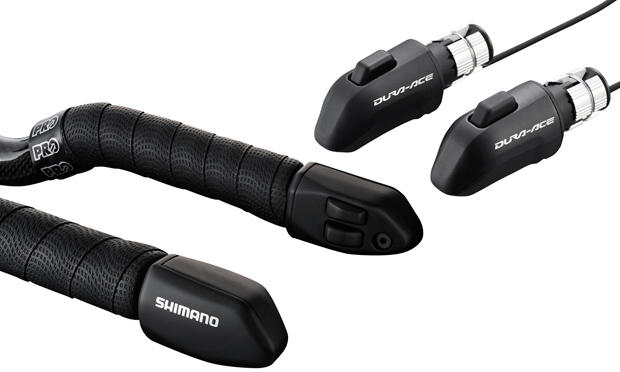
Campagnolo, hands down, has the most intuitive electronic bar-end shifter. What did it do? It just made the shifter act like a mechanical shifter. Imagine a grandfather clock that's entirely electronic, no chimes, but still goes tick, tick and makes chime noises on the quarter hour. Campy's shifters operate just like mechanical shifters, feel like mechanical shifters, but are electronic. Campy appealed to the Neanderthal in us. Shimano gave us all way too much credit.
What is the relative value of electronic versus mechanical shifting? This question comes up all the time on our reader forum. "I can afford either a Felt B2 with standard wheels or a Felt B14 with aero wheels. The B2 has electronic shifting. Which should I buy?"
On our reader forum one respondent suggested the B2, offering, "Other than the cost, there is really no shortage of good things to say about Di2 shifting."
To this, another responded, "What you've just said is one of the most insanely idiotic things I have ever heard. At no point in your rambling, incoherent response were you even close to anything that could be considered a rational thought. Everyone in this forum is now dumber for having read it."
He obviously argued in favor of the B14. Life is never dull moderating the Slowtwitch Reader Forum. (Both front and rear Dura Ace electronic derailleurs are pictured below, and Ultegra electronic is substantially similar in function.)
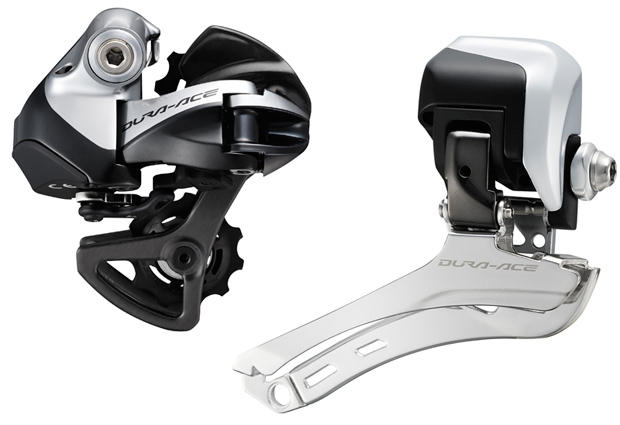
How would I answer that question? Boy, I don't know. I am fine with either mechanical or electronic and, honestly, I prefer mechanical on my road bikes. I prefer electronic on my tri bikes because of FD auto-trim, and because there's virtually no chance of derailing the chain. But mechanical bar-end shifters are more intuitive than buttons. I never miss a shift on Shimano electronic, that is, the electronic system always does what I ask it to do. Just, sometimes I ask it to do the opposite thing that I want, because I've taken the affirmative act to push what turns out to have been the wrong button (if that makes sense).
Mechanical
Below is pictured Shimano's mechanical Ultegra groupkit and the current numerical designation is 6800. This group replaced Ultegra 6700. Dura Ace has "numbers" in the 9000s rather than the 6000s. Current Dura Ace mechanical is series 9000, and electronic is 9070. Dura Ace is Shimano's top-of-the-line groupkit. Ultegra is next down. It's electronic group is numbered 6870. So, you just add 70 to whatever the mechanic number is and you get the electronic version, if there is an electronic version.
Why does Shimano have brand designations that are both numerical as well as prosaic or textual? The number is descriptive of the generation, while the textual name never changes. Ultegra has, as a brand, been around for decades, but prior to Ultegra 6800 we were buying Ultegra 6700. So, the numerical designation will tell you the generation or era of the group. This, rather than the year, because Shimano does not calibrate its new product introductions to the calendar year or to any 12-month period.
Shimano's next level down is 105, and that is the textual name. Wait! Isn't 105 a number? Yes, but no. Its numerical designation is 5800. So, you have 105 5800 and just prior to that was 105 5700. Tiagra is one rung below and we're now at 4700 for Tiagra, which means I assume that 4800 is coming, and that's something to consider. The *800 technology hasn't yet flowed to Tiagra, since it's still sitting at *700 designation.
What are these upgraded technologies that flow down from a higher group to a lower group? It might be a change from, say, 10sp to 11sp, or the new ergonomics and softer action of a road shift/brake lever, or the introduction of a road hydraulic disc brake. It might be a change in crank bolt pattern (more on that below.) All component companies do this. What you want, if you're looking for value, is the most recently upgraded downstream groupkit. The moment 105 changed its numerical designation from 5700 to 5800 is the moment 105 probably became the best value, which happened within the last year.
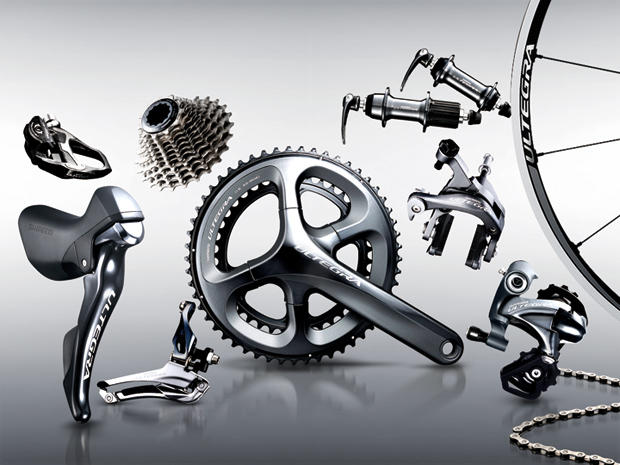
SRAM doesn't yet offer an electronic group, so, who rules in mechanical, for triathlon between SRAM or Shimano? I'm going to answer in the context of each company's 2x drive trains (2x pronounced "two by"), and this means 11 gears in the back and 2 gears in the front. There has been some talk on our reader forum of the validity of 1x in tri, but I'm going to have that discussion elsewhere.
SRAM is like the classically trained tennis player with beautiful ground strokes, but who might be less adept at reacting to non-standard tactics. While SRAM employs terrific engineers, in my analogy SRAM is the wily court rat who'll junk you to death. SRAM, tactically, seems to try to find the opening Shimano has not exploited, as with bar-end shifters, plug-in brake levers, a cassette everybody wants but nobody makes, like 11-26, 11-28 or 11-32. SRAM got onto compact (110mm bolt pattern) cranks early, offering 50×34 and 52×36.
Shimano eventually bridges the gap, and that thing we want that Shimano doesn't make, it eventually makes. Like 110mm BCD cranks, which I think are important for triathlon. And 11-28 11sp cassettes. These are important if you intend to ride your bike up hills. Triathlon is not like a road race, where your average power might be 180 watts but you're riding 400 watts up the hills or you lose contact.
In a triathlon, if your average power over a 56mi course is 220w, you'd better not being doing much more than 250w while climbing. I typed in my weight, small chain ring, and 250w for power into cyclingpowerlab.com and came up with a 34×28 gear if I wanted to ride up an 8 percent grade at a cadence of 77. I'll do lots of races this year with grades between 7 and 9 percent in California, where I most often race.
Shimano, not that long ago, was not a drive train I could use for tri because it didn't offer gears small enough. Now, with a standard cage derailleur allowing 50×34 and 11-28 I can ride Shimano successfully. (I can ride this combo aboard a bike with Shimano Dura Ace or Ultegra, electronic or mechanical.) The problem is now that, even after Shimano began making the "right" gearing for tri bikes, it's not easy finding bike brands that spec this gearing on their tri bikes (but that's not Shimano's fault.)
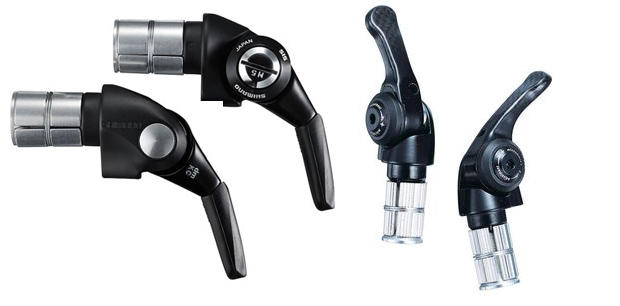
Still, when it comes to finding a way to win, Shimano does have one component class that it hasn't upgraded, and it's the mechanical bar-end shifter. SRAM, lobbed some junk over the net at Shimano by making a true bar-end shifter. Shimano has relied on road handlebar thumb shifters dating back to the early 1980s, retasking it as its bar-end shifter, simply updating the design for extra gears (8sp to 9sp, to 10sp, to 11sp). Above is a picture of Shimano's bar-end shifter, alongside a MicroSHIFT bar-end shifter and we'll talk about MicroSHIFT further below).
Why make a big deal about this one item? Because SRAM often finds the tactile thing to upgrade, and that's what's obvious to the rider. Will you feel the difference in a change in crank bolt pattern? No. Will you feel the difference between one shifter and another? Yes.
Cross/down-spec
There isn't anything Shimano makes that isn't at the apex in functionality, including brakes. It's just that Shimano is going to get picked apart by bike companies that either want their own proprietary brakes on their bikes; or they're in a partnership with Magura or Tririg. Shimano's road brakes are more likely to go on the lower-end (non-Superbike) tri bikes because those bikes don't require brake calipers that go under the bottom bracket or behind something or inside something. Typical road brake calipers are "side pull" and that's not sexy to a lot of tri bike makers and customers.
But, by the time you get "down" to these mortal tri frames the price point is cheap enough that the bike maker is downspec'ing the brake calipers, so you still might not see Shimano's brakes. If your bike is equipped with Shimano's brakes you will enjoy superior braking performance, as would be the case with standard caliper brakes by SRAM or Campy.
So, other than less-than-intuitive electronic bar-end shifters, and attention-not-paid to mechanical bar-end shifters, Shimano's pretty much got it all, with the exceptions noted below in the "compatibility" discussion.
The one exception is the mechanical bar-end shifter and I'm only harping on this to tell you the one area where there might actually be an upgrade from Shimano. Shimano's bar-end shifter was never designed to be that. It was a so-called thumb shifter, and it stuck in the ends of road bars. It was an alternative to down tube shifters, before Shimano moved the shifter to the brake lever (STI). In the early days we called Shimano's thumb shifters "Barcon" shifters, ironic because a "Shimano Barcon" was an incongruity. Barcon was a Sun Tour brand name. (Sun Tour and its technologies – the slant parallelogram, it's cassettes – one day I'm going to write about the most advanced cycling technology company you've never heard of.)
There is pretty much no chance Shimano is ever going to update a product (bar end shifter) that looks, smells and tastes different than it did 30 years ago. I'm sure it believes that the mechanical bar-end shifter will become an irrelevant category altogether as we move to electronic. It's probably right.
But we still do have mechanical shifting in the ends of our aerobars and if you're using Shimano as your mechanical groupkit the one cross-spec to consider is MicroSHIFT. It does not explode into a thousand pieces when you take it off the bike, and those who ride the product like the ergonomics and shifting. I haven't found anyone who likes them less than Shimano's bar ends. They seem to shift with less effort. That image above is MicroSHIFT (right) versus Shimano bar-end (left).
Shimano never has enjoyed the "groupkit integrity" that Campagnolo fans require. Even SRAM groups are unlikely to be picked apart by bike product managers. But Shimano seems to suffer down-spec more than others and I think this began 25 years ago, when Shimano had a very different pricing structure to OEMs and those who didn't enjoy Shimano's lowest OEM pricing had to compete through swapping out brakes, cassettes, cranks, BBs, and hubs for products made by other manufacturers. Also, Shimano's ubiquity and strength also invites down-spec'ing. It becomes difficult for bike brands to compete, pricewise, with a ton of other similar bikes all carrying the same parts.
So you'll see MicroSHIFT, FSA, Vision Tech, KMC and other parts showing up on Shimano-shifted brakes, as well as wheels from other companies. How well does this work? How does a Vision Tech TriMax crankset work with a Shimano electronic shift system? When this cross- or down-spec occurs we'll deal with these questions bike-by-bike, as we overview triathlon's most popular bikes. What you are less likely to see is just an entire Shimano 105 kit on a tri bike, and that's probably too bad. You're more likely to see Ultegra derailleurs along with non-Shimano cranks, chains, and so forth.
Compatibility
Every component company will tell you what its shifting performance will only be found only when its parts are used throughout the drive train. While that might be true technically, is it true actually, in terms of what you can feel?
Sometimes yes, sometimes no. Will Wippermann chains work as well on a Campagnolo group as a Campagnolo chain? Will FSA chain rings work as well on a 9070 drive train as a Shimano chain? In Wippermann's case, probably yes. FSA? Depends on the quality of the chain ring.
The one area of incompatibility I should mention are *800 cranks. When Shimano move from Ultegra 6700 to 6800 it moved to a new, 4-bolt crank, and you can see these cranks in the Dura Ace and Ultegra groupkit images above (same with 105). You'll note that we wrote recently about new introductions and price drops in crank-based power meters. If you're interested in the Pioneer system, this is compatible with the 4-bolt systems. But many of you were favorably impressed with the Powertap chain-ring-based system, and that is only available for 5-bolt, 110mm (Compact) bolt patterns. If you want a power meter based around a crank or chain ring system, consider this before you buy the bike. Make sure the bike you buy is spec'd with a conforming crank, or have the retailer swap out the crank at the point of purchase.
One other consideration: Shimano doesn't offer crank arms shorter than 165mm. This is a popular aftermarket option for a lot of smaller riders in triathlon. Bear all this in mind as you contemplate a bike from your retailer: better to buy that bike best optimized at the point of purchase.
Shimano's other stuff
Wheels, shoes, pedals and other products Shimano makes are not part of this overview, as we will handle shoes in shoe reviews, PRO handlebars (owned by Shimano) when we review handlebars, and so forth.
Notes: All the images above are courtesy Shimano except that with the 2-button brake lever. Those interesting in playing around with power, gear and cassette options on cyclingpowerlab.com will want to look at Power Models => Power-Cadence Calculator.


